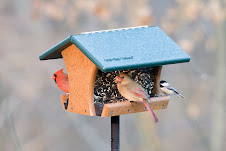
Goldfinches are one of the latest nesters of the breeding season. They wait until the natural thistle weeds are ripe with silky down that the finches use to line the interior of their nest. This is a wonderful time to attract them using their favorite Nyjer Seed in your feeders. After nesting the beautiful bright yellow breeding plumage that they sport all summer will soon fade into their dull drab winter coloration as they begin their fall molt.
If you haven’t been attracting goldfinches to you feeder or their activity has been sporatic, you should clean your feeder and replace your nyjer. Clean your feeders using a 10% bleech and water solution. It is helpful to loosen up that crusty old seed with a long handled tube feeder brush. We have these available in the store. Finally, let your feeder thoroughly dry in the sun before filling.
The oils in Nyjer seed begins to dry out after extended storage (6+ months plus). Test the freshness by placing a pinch of nyjer on a piece of white paper. Crush the seeds with the backside of a spoon. The paper should have oil spots that appear to be “wet” if the seed is good and fresh. Don’t miss out on their last big show and help them with their nesting duties with a fresh supply of Nyjer Seed.
If you haven’t been attracting goldfinches to you feeder or their activity has been sporatic, you should clean your feeder and replace your nyjer. Clean your feeders using a 10% bleech and water solution. It is helpful to loosen up that crusty old seed with a long handled tube feeder brush. We have these available in the store. Finally, let your feeder thoroughly dry in the sun before filling.
The oils in Nyjer seed begins to dry out after extended storage (6+ months plus). Test the freshness by placing a pinch of nyjer on a piece of white paper. Crush the seeds with the backside of a spoon. The paper should have oil spots that appear to be “wet” if the seed is good and fresh. Don’t miss out on their last big show and help them with their nesting duties with a fresh supply of Nyjer Seed.









